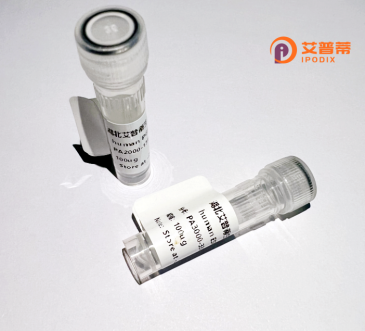
| 纯度 | >90%SDS-PAGE. |
| 种属 | Human |
| 靶点 | STXBP2 |
| Uniprot No | Q15833 |
| 内毒素 | < 0.01EU/μg |
| 表达宿主 | E.coli |
| 表达区间 | 1-593 aa |
| 活性数据 | MAPSGLKAVV GEKILSGVIR SVKKDGEWKV LIMDHPSMRI LSSCCKMSDI LAEGITIVED INKRREPIPS LEAIYLLSPT EKSVQALIKD FQGTPTFTYK AAHIFFTDTC PEPLFSELGR SRLAKVVKTL KEIHLAFLPY EAQVFSLDAP HSTYNLYCPF RAEERTRQLE VLAQQIATLC ATLQEYPAIR YRKGPEDTAQ LAHAVLAKLN AFKADTPSLG EGPEKTRSQL LIMDRAADPV SPLLHELTFQ AMAYDLLDIE QDTYRYETTG LSEAREKAVL LDEDDDLWVE LRHMHIADVS KKVTELLRTF CESKRLTTDK ANIKDLSQIL KKMPQYQKEL NKYSTHLHLA DDCMKHFKGS VEKLCSVEQD LAMGSDAEGE KIKDSMKLIV PVLLDAAVPA YDKIRVLLLY ILLRNGVSEE NLAKLIQHAN VQAHSSLIRN LEQLGGTVTN PGGSGTSSRL EPRERMEPTY QLSRWTPVIK DVMEDAVEDR LDRNLWPFVS DPAPTASSQA AVSARFGHWH KNKAGIEARA GPRLIVYVMG GVAMSEMRAA YEVTRATEGK WEVLIGSSHI LTPTRFLDDL KALDKKLEDI ALP |
| 分子量 | 66.4 kDa |
| 蛋白标签 | His tag N-Terminus |
| 缓冲液 | PBS, pH7.4, containing 0.01% SKL, 1mM DTT, 5% Trehalose and Proclin300. |
| 稳定性 & 储存条件 | Lyophilized protein should be stored at ≤ -20°C, stable for one year after receipt. Reconstituted protein solution can be stored at 2-8°C for 2-7 days. Aliquots of reconstituted samples are stable at ≤ -20°C for 3 months. |
| 复溶 | Always centrifuge tubes before opening.Do not mix by vortex or pipetting. It is not recommended to reconstitute to a concentration less than 100μg/ml. Dissolve the lyophilized protein in distilled water. Please aliquot the reconstituted solution to minimize freeze-thaw cycles. |
以下是3条与重组人STXBP2蛋白相关的参考文献示例(部分内容为简化概括,请以实际文献为准):
---
1. **文献名称**:*STXBP2 mutations in familial hemophagocytic lymphohistiocytosis type 5*
**作者**:Côte M. et al.
**摘要**:研究揭示了STXBP2基因突变导致家族性嗜血细胞性淋巴组织细胞增多症(FHL5)的机制,发现STXBP2蛋白通过与突触融合蛋白Syntaxin-11互作调控细胞毒性颗粒胞吐作用,其功能缺失造成免疫细胞脱颗粒异常。
2. **文献名称**:*Structural basis for the interaction between STXBP2 and Syntaxin in vesicular trafficking*
**作者**:Liu Y. et al.
**摘要**:通过X射线晶体学解析了STXBP2蛋白与Syntaxin-11的结合界面结构,揭示了其通过α螺旋结构域稳定Syntaxin构象,从而促进分泌囊泡与质膜融合的分子机制。
3. **文献名称**:*Impaired cytotoxic lymphocyte degranulation in STXBP2-deficient patients*
**作者**:Zur Stadt U. et al.
**摘要**:临床研究发现STXBP2缺陷患者的NK细胞和T细胞无法正常释放穿孔素和颗粒酶,导致免疫失控,证实了该蛋白在细胞毒性效应中的关键作用及与FHL5病理的直接关联。
---
**提示**:以上为示例性内容,建议通过PubMed或Web of Science检索关键词“STXBP2”“syntaxin-binding protein 2”“FHL5”获取最新文献。真实研究多聚焦于STXBP2的免疫调节功能及与遗传性疾病的联系。
Syntaxin-binding protein 2 (STXBP2), encoded by the STXBP2 gene, is a crucial regulatory protein involved in intracellular vesicle trafficking and membrane fusion processes. It belongs to the SEC1/Munc18 (SM) protein family, which interacts with SNARE (soluble N-ethylmaleimide-sensitive factor attachment protein receptor) complexes to mediate exocytosis. Specifically, STXBP2 binds to syntaxin 11 (STX11), facilitating vesicle docking and secretion in immune cells like cytotoxic T lymphocytes and natural killer (NK) cells. This interaction is essential for lytic granule exocytosis, a critical mechanism for immune response and pathogen clearance.
Mutations in STXBP2 are linked to familial hemophagocytic lymphohistiocytosis type 5 (FHL5), a rare autosomal recessive immune disorder characterized by uncontrolled cytokine release and impaired cytotoxic lymphocyte function. Patients often present with fever, hepatosplenomegaly, and severe systemic inflammation. Recombinant human STXBP2 protein is produced using expression systems (e.g., E. coli or mammalian cells) for research and therapeutic development. It aids in studying molecular mechanisms of vesicle transport, restoring cellular function in disease models, and exploring targeted therapies for FHL5. Ongoing research focuses on its structural dynamics, interaction networks, and potential applications in gene therapy or protein replacement strategies.
×